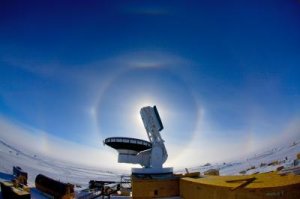If dark energy is pushing the universe apart at an accelerating clip, when did its effects begin to be felt? One way to study that question is through the Cosmic Microwave Background, whose infinitesimal variations in density and temperature give us an idea of what was happening a scant 400,000 years after the Big Bang. We should be able to find information in the CMB about how dark energy affected the formation of galaxy clusters by comparing CMB evidence against what we see in these clusters today.

And that makes ‘first light’ at the National Science Foundation’s South Pole Telescope a noteworthy event. The 75-ft tall telescope has been under assembly and testing since November, and its February 16 test run was a success. Now the pole’s cold, dry air will allow long-term Earth-based study of the CMB with little interference from water vapor. The Sunyaev-Zeldovich effect, which distorts CMB radiation as it encounters the gases in intervening galaxy clusters, will help scientists image the gases in these clusters.
Image: Backlit South Pole Telescope in profile, with sun dog (arc and rainbow), caused by ice crystals. Credit: Jeff McMahon.
The potential data windfall from galaxy clusters is immense with this instrument. Says John Carlstrom (University of Chicago), who headed the team that tested the telescope:
“To get a meaningful constraint on dark energy through measuring galaxy clusters, you need something like this South Pole Telescope. The cluster SZ [Sunyaev-Zeldovich] signals cover small patches in the sky relative to the intrinsic variations in the cosmic microwave background. To get the necessary resolution, you need a big telescope. Now we have one.”
At an altitude of 3000 meters on the Antarctic ice sheet, the Amundsen-Scott South Pole Station must be the nearest thing to a space-based telescope on Earth. The first major project for the instrument is a survey that is expected to reveal thousands of galaxy clusters, helping us to refine our knowledge of dark energy’s effects over time. More information is available at the South Pole Telescope homepage.


Is there a higher-rez version of the above photo with the sun dog? I tried the telescope’s website, but didn’t find any pictures like that.
I imagine a higher-res version will eventually show up on the SPT site — check tomorrow, perhaps, as it’s bound to wind up there pretty quickly. For the moment, the one posted is as good as I can find. I’ll pass along any info if I find another one for you.
I just wanted to ask a question about the so called Dark energy 0 if anyone know the answer.
Current science tells us that the Universe’s rate of acceleration has recently increased, and current thinking says this is to do with the Dark Energy acting as a repulsive force.
Do we know how we know that the repulsive force is accelerated?
No, we do not
Rather we do not know how it is accelerated if that is the question. We do know about the acceleration because as we look at Type Ia supernovas that are further and further away we look back in time and we see these standard candles as being less bright than they ‘should’ be indicating that the universe is growing bigger at an accelerating rate.
philw
Got it. Thanks for the explanation.
Rodney: The peasants are revolting!
King: You can say that again!
===
Dark Energy is a repulsive concept.